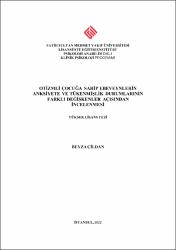Otizmli Çocuğa Sahip Ebeveynlerin Anksiyete ve Tükenmişlik Durumlarının Farklı Değişkenler Açısından İncelenmesi
Citation
ÇİLDAN, Beyza, Otizmli Çocuğa Sahip Ebeveynlerin Anksiyete ve Tükenmişlik Durumlarının Farklı Değişkenler Açısından İncelenmesi, Fatih Sultan Mehmet Vakıf Üniversitesi Lisansüstü Eğitim Enstitüsü Psikoloji Anabilim Dalı Klinik Psikoloji Programı, Yayımlanmamış Yüksek Lisans Tezi, İstanbul 2022.Abstract
Bu çalışmanın amacı çocuklarında otizm spektrum bozukluğu olan ebeveynlerin anksiyete ve tükenmişlik durumlarının ebeveynin sosyo-demografik özelliklerine, çocuğun otizmin ağırlık derecesine ve ebeveynin çocuğa bakım verme yılına göre nasıl farklılaştığını incelemektir. Çalışmaya 24-60 yaş arasında toplam 140 kişi katılmıştır. Araştırmada ebeveynlerin ve çocuklarının sosyo-demografik bilgilerini içeren bir demografik bilgi formu, Beck Anksiyete Ölçeği ve Maslach Tükenmişlik Ölçeği kullanılmıştır. Verilerin analizinde normal dağılıma uyan değişkenler için Bağımsız Örnek t-Testi, Tek Yönlü Varyans Analizi (ANOVA), Welch Testi; normal dağılıma uymayan değişkenler için ise Mann Whitney U ve Kruskal Wallis Testleri kullanılmıştır. Ebeveynlerin anksiyetelerinin cinsiyet, çalışma durumu ve yaş değişkenlerine göre farklılaştığı; eğitim durumu, gelir durumu, çocuğun otizm ağırlık derecesi ve çocuğa bakım verme yılı değişkenlerine göre ise farklılaşmadığı görülmüştür. Tükenmişliklerinin ise cinsiyet, çalışma durumu, yaş, eğitim durmu, gelir durumu, çocuğun otizm ağırlık derecesi ve çocuğa bakım verme yılı değişkenlerinden hiçbirine göre farklılık göstermediği bulunmuştur. Ebeveynlerin duygusal tükenmişliklerinin bakım verme yılı değişkeni hariç tüm değişkenlere göre farklılaştığı görülmüştür. Kişisel başarılarının ise cinsiyet, çalışma durumu, çocuğun otizm ağırlık derecesi ve çocuğa bakım verme yılı değişkenlerine göre farklılık gösterdiği; yaş, eğitim ve gelir durumu değişkenlerine göre farklılık göstermediği bulunmuştur. Beck Anksiyete Ölçeği’nin “Sıcak/ateş basmaları”, “Çok kötü şeyler olacak korkusu”, “Ölüm korkusu” ve “Korkuya kapılma” maddelerinin cinsiyete göre farklılaştığı gözlenmiş ve tüm maddelerde kadınların ortalamasının erkeklerden daha yüksek olduğu görülmüştür. Elde edilen bulgular literatür çerçevesinde tartışılmıştır. The aim of this study is to examine how the anxiety and burnout levels of parents of children with autism spectrum disorder differ according to the socio-demographic characteristics of the parents, autism severity of child, and the parent's years of caring for the child. 140 people aged 24 – 60 years participated in the study. A demographic information form, Beck Anxiety Inventory and Maslach Burnout Inventory were administered to the participants. Independent Sample t-Test, One-Way ANOVA, Welch Test for the variables that were normally distributed; Mann Whitney U and Kruskal Wallis Tests for the variables that were not normally distributed were applied. It was observed that parents' anxiety differed according to gender, employment status and age; did not differ according to the variables of education status, income status, autism severity of the child and years of caring for the child. It was found that their burnout levels did not differ according to any of the variables. It was observed that the emotional burnout of the parents differed according to all the variables except years of caring for the child. It was found that personal achievement of parents differed according to the variables of gender, employment status, severity of autism and years of caring for the child; did not differ according to the variables of age, education and income status. It was observed that the items of "Feeling hot", "Fear of worst happening", "Fear of dying" and "Scared" of Beck Anxiety Inventory differed according to gender, and it was found that the average of women was higher than men in all items. The findings were discussed within the framework of the literature.



















